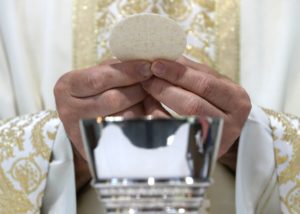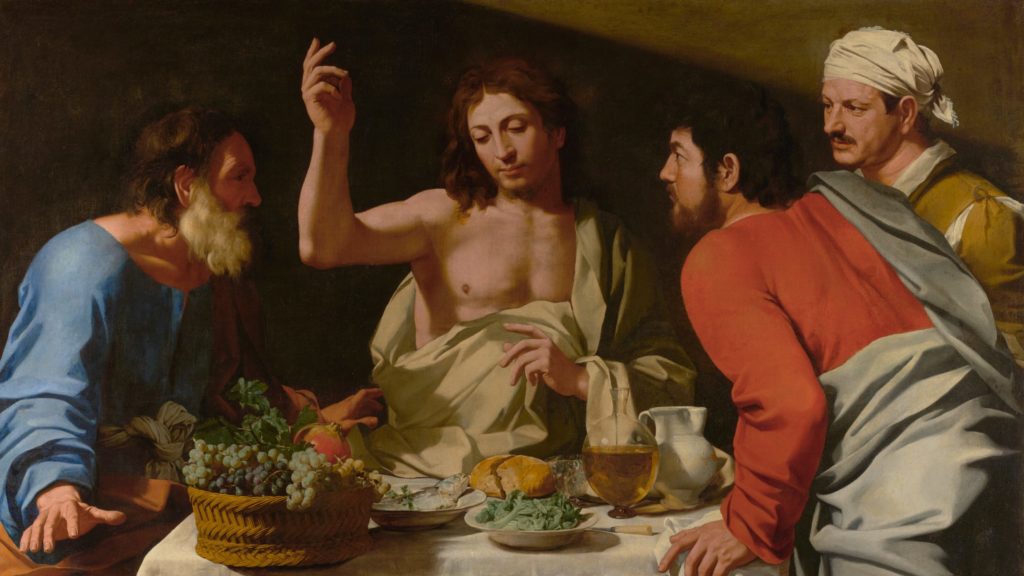The U.S. bishops are encouraging Catholics to deepen their love for the Eucharist as part of the ongoing National Eucharistic Revival initiative. In light of that effort, the following is the final installment in a series from Angelus contributing editor Mike Aquilina on the meaning and makeup of the Eucharistic Prayers.
If God is everywhere, does it make sense to speak of his “real presence” in the Eucharist? An omnipresent God is already here, and always here.
He says in the Book of Jeremiah: “Can anyone hide in secret without my seeing them? Do I not fill heaven and earth?’ (Jeremiah 23:24).
And the Book of Proverbs bears witness: “The eyes of the LORD are in every place, keeping watch on the evil and the good” (Proverbs 15:3).
Yet we can in the Book of Genesis that Adam and Eve enjoyed a far greater intimacy with God. It was his custom to walk about in their garden at certain times of day (Genesis 3:8). They had that kind of nearness — and they lost it through their sin. They were banished from his presence to live in exile (Genesis 3:23–24).
Through the rest of the Old Testament, God’s people drew close to him by means of sacrifice. In their offerings they expressed sorrow for their sins, and presented animal victims who suffered the death that was the sinner's just punishment. By placing a hand on the sacrificial victim, the sinner identified with it.
Sacrificial worship was the precondition for intimacy with God. The Jewish scholar Baruch Levine described all the prescriptions in the Book of Leviticus as etiquette for “meals eaten in the presence of God.”
Along with the animal sacrifices, Israel made a perpetual offering of “the Bread of the Presence” (Exodus 25:30). The bread was transformed and made holy by its nearness to God. According to the Mishnah, the authoritative collection of the testimonies of the ancient rabbis, “On the table of marble [the priests] laid the Bread of the Presence when it was brought in, and on the table of gold they laid it when it was brought out, since what is holy must be raised and not brought down.”
Only the priests could eat this bread, though three times a year they exhibited it to the people and proclaimed’ “Behold God's love for you.”
The people could see the holy bread and know God’s presence, but they could not receive his holiness.
Through the sacrificial system prescribed in the Law, God had established a special mode of presence. He was there for his people — first in the tabernacle and then in the Temple — but they could only draw so close. It was not the intimacy Adam and Eve had known in the garden.
God created Adam to be the high priest of his creation, but Adam forfeited that office by sinning. All the priests of the tabernacle and Temple were similarly sinful. But the prophets foresaw a day when not only Israel, but the whole world, would be restored to fellowship with God. At that time, “from the rising of the sun to its setting,” the name of God would be “great among the nations” and incense offered to his name everywhere, “and a pure offering” (Malachi 1:11).
The priest who would restore God’s nearness was Jesus Christ, who would walk the paths of the earth during his ministry — and then establish his eucharistic presence forever in his Church.
He made the matter abundantly clear in his lengthy “Bread of Life Discourse” in John’s Gospel (John 6:22–66). He declared his flesh to be bread and food for the world. The more people challenged him, the more emphatically he stated his case.
At his Last Supper, he fulfilled his promise by declaring the unleavened bread to be his body and the cup of wine to be his blood (Luke 22:19–20).
It was a presence his disciples would not just see from distance, but also consume. Their flesh would mingle with his. His blood would course through their bodies.
St. Paul would speak of this mingling as a communion — in Greek, “koinonia,” sometimes translated as “participation” or “sharing.” “The cup of blessing that we bless, is it not a communion in the blood of Christ? The bread that we break, is it not a communion in the body of Christ?” (1 Corinthians 10:16).
St. Peter declared infallibly that, through the Church’s sacramental life, the Lord’s disciples “come to share in the divine nature” (2 Peter 1:4).
These early Christians described a presence and a communion greater than Adam had ever known.
The Catechism of the Catholic Church describes this sacramental presence as “altogether special” (1509) and “unique” (1374). “When his visible presence was taken from them, Jesus did not leave his disciples orphans. He promised to remain with them until the end of time; he sent them his Spirit. As a result, communion with Jesus has become, in a way, more intense” (788).

In the Mass, believers anticipate the union they will enjoy fully in heaven. Christ is present as truly in the sacrament as he is in heaven. St. Paul explained: “At present we see indistinctly, as in a mirror, but then face to face … then I shall know fully, as I am fully known” (1 Corinthians 13:12). And St. John said’ “we know that when he appears we shall be like him, for we shall see him as he is” (1 John 3:2).
The communion every Christian hopes to enjoy forever in heaven begins now at every Mass. The presence and communion are as real as it will be. The only difference is in the believer’s ability to perceive it.
For more on the Bread of the Presence, see Margaret Barker’s book “Temple Themes in Christian Worship.”

